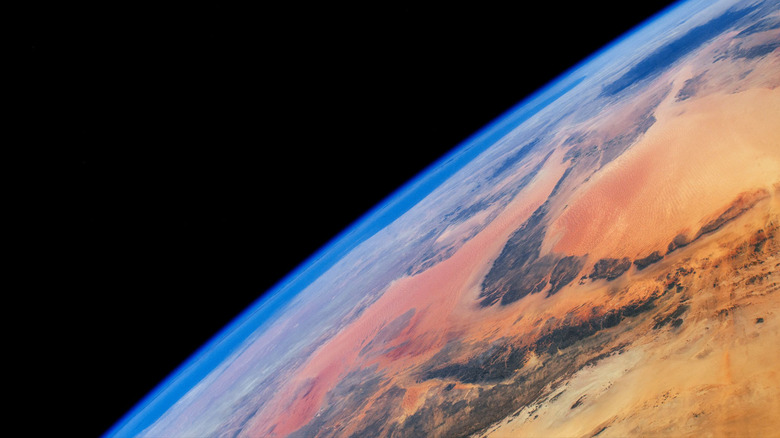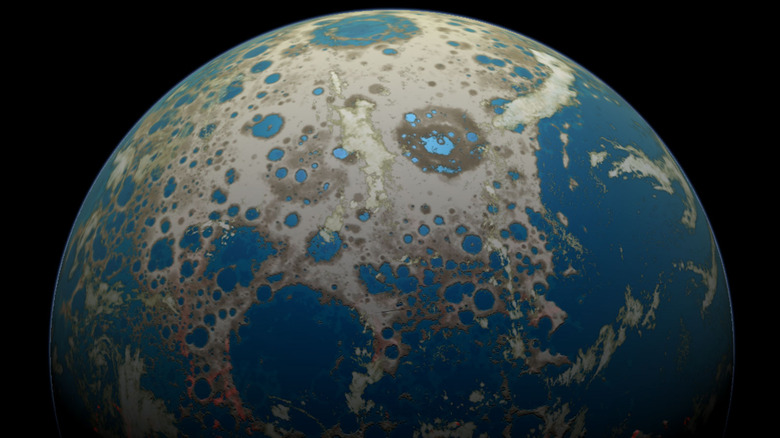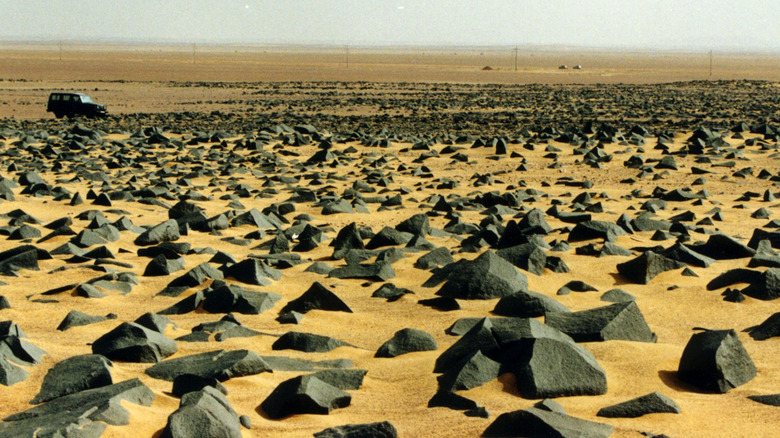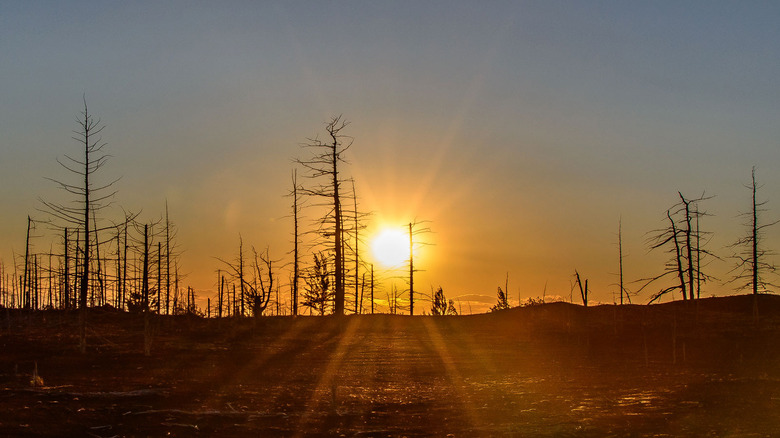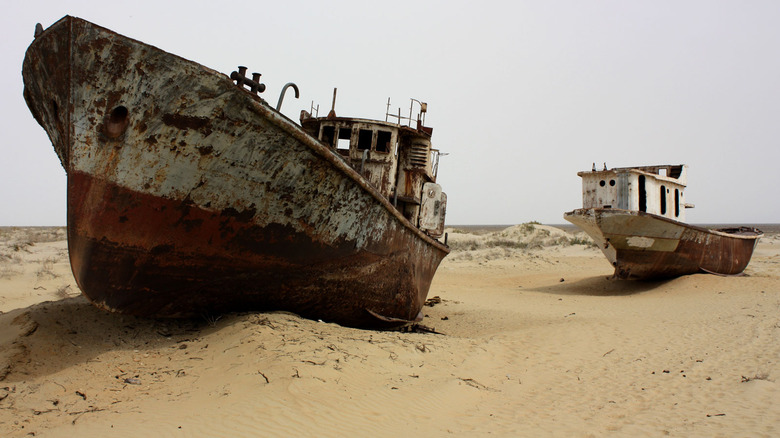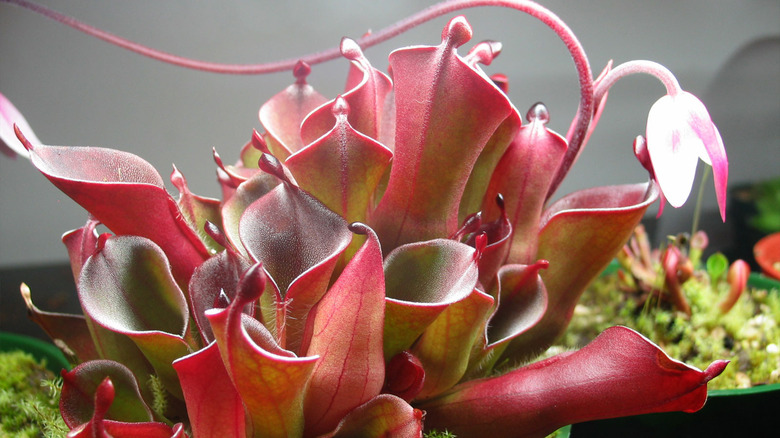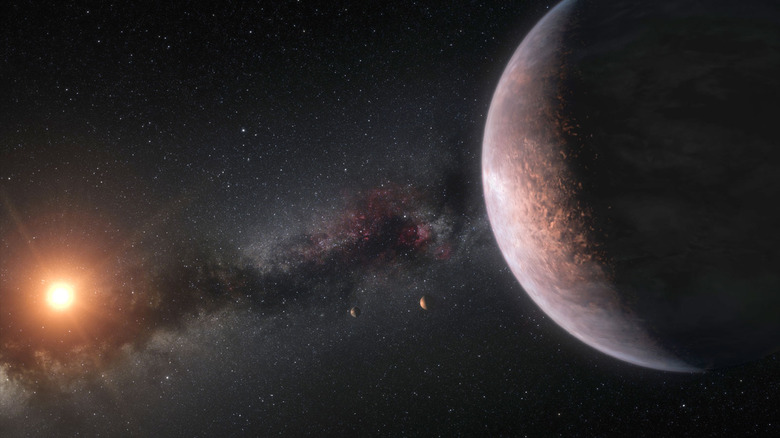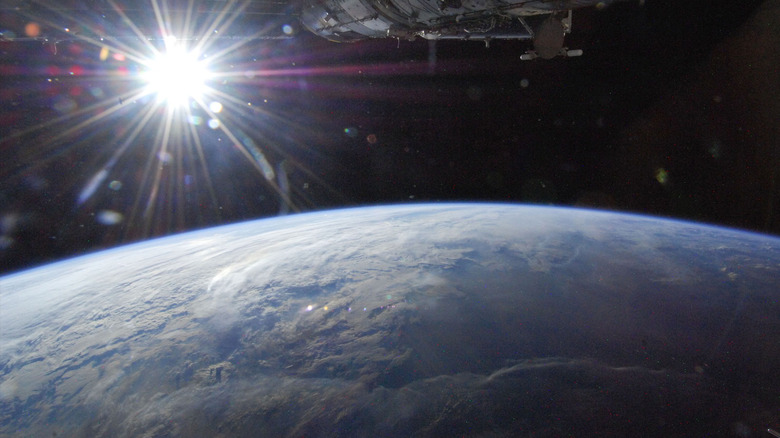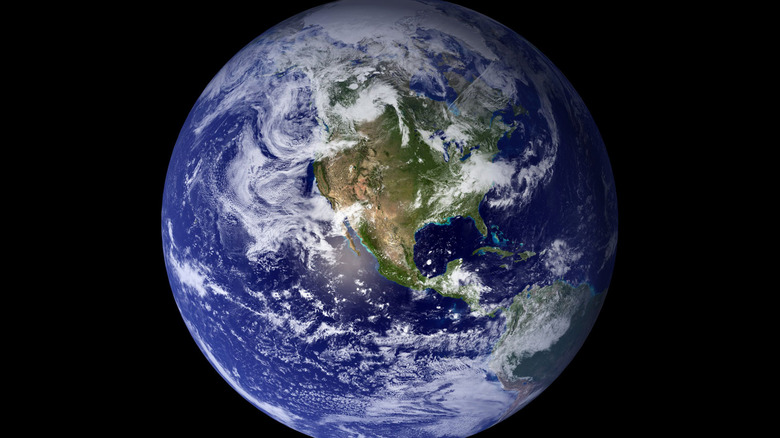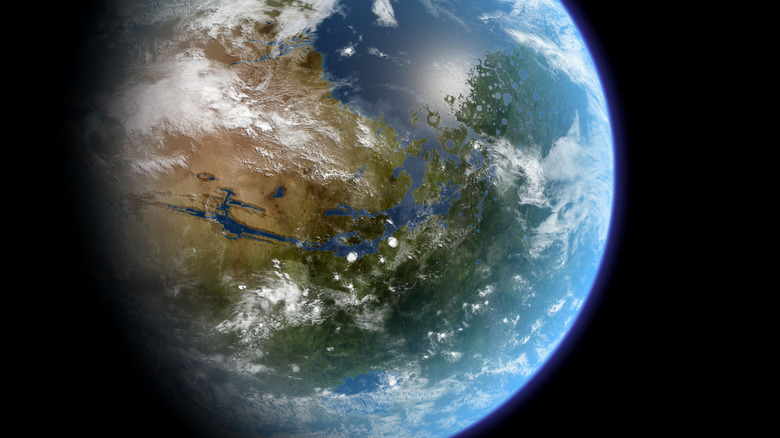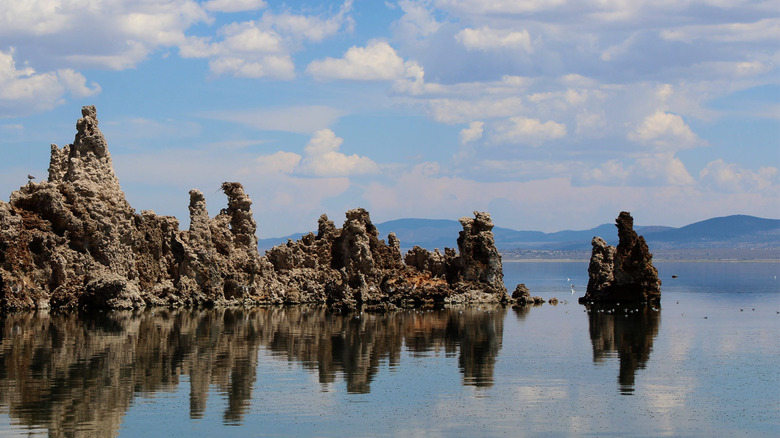What Would Happen If The Earth Ever Ran Out Of Oxygen?
Simply put, if Earth was to run out of oxygen, life as we know it would suffocate. The bad news is, this will almost definitely happen someday. The good news, at least for humanity in the 21st century: it won't be anytime soon. In 2021, scientists published a grim-sounding study in Nature Geoscience predicting that in roughly a billion years Earth will have no oxygen left, forcing the planet to return to a barren ball of rock.
This may all sound rather gloomy. There's no way to sugarcoat the fact that, in enough time, even the planet itself will meet its inevitable demise. The truth is, however, that this is simply a part of nature. Nothing lasts forever. Not even planets or stars. Speaking with New Scientist about the study, lead author Kazumi Ozaki explains bluntly that the oxygen in Earth's atmosphere is most certainly not permanent. By the year one billion, all of nature's diversity will be gone, leaving primitive bacteria as Earth's only inhabitants.
What exactly makes a planet habitable is still a matter of ongoing research, as a paper published in the journal Astrobiology discusses, and seemingly a planet's ability to support life is more of a spectrum than a clear binary distinction. In other words, Earth won't suddenly run out of air in a single day, leaving everything to suffocate. Instead, it'll be a much slower, gradual process. And a hint of what Earth's distant future might look like comes from Earth's distant past.
The Oxygen Catastrophe
When Earth was a newly formed world, there was no oxygen at all. Nor was there any life on this planet. As a page from the University of California Museum of Paleontology explains, Earth's surface first cooled enough to become solid around 3.8 billion years ago, and the earliest life arose a few million years later, with the oldest known fossils dating back 3.5 billion years. The atmosphere at the time, however, was completely unrecognizable: A toxic mixture of gasses, like methane and ammonia, deadly to most life today.
Earth's life is what created the oxygen which is so essential for the world to keep going but, when it first filled the air, oxygen was deadly. In an event known as The Oxygen Catastrophe (or, more formally, the Great Oxidation Event), Earth's atmosphere became so enriched with oxygen that it left a band of rust trapped in the geological record, as noted by the University of Melbourne. The American Society for Microbiology elaborates further, explaining how cyanobacteria learned to harvest sunlight, producing the oxygen which all of Earth's animals now depend on.
Using sunlight, life quite literally changed the world, shaping the atmosphere into what it is today. Some studies, like one published in BMC Evolutionary Biology, even argue that without oxygen, complex life may never have evolved on Earth. Seemingly though, the thing which will eventually kill Earth is the same thing that brought it to life – the Sun.
The ever-brightening Sun
Like the Earth, the Sun won't last forever. It has a limited supply of hydrogen fuel to burn up in nuclear fusion and, as it runs out, it will change over time. As Space.com explains, in the final stages of the Sun's life, it will run out of usable hydrogen completely and swell into an enormous red giant star, devouring Mercury and Venus. If Earth manages to escape this same fate, it'll be charred to a cinder. But the Sun will spell doom for the Earth long before this happens.
Over the course of its life, the Sun has been gradually becoming brighter. As New Scientist explains, since it first ignited around 4.5 billion years ago, the Sun has become around 30% brighter. Over the next billion years or so, it's due to brighten by a further 10%. This change will eventually become too much for Earth to handle.
Earth currently sits comfortably in the Sun's habitable zone – the distance at which the planet receives the right amount of light for liquid water to exist on its surface. As the Sun continues to brighten, however, this zone will gradually shift outwards. A stark warning of what this might mean for Earth, is planet Venus, with its roasting hot atmosphere and choking clouds. As The Planetary Society explains, there's a good chance that the Sun's slowly but steadily increasing light may be what made Venus the dry and lifeless place it is today.
Doomed by sunlit stone
It isn't the plants that will be affected first by the brightening Sun, but the rocks. Part of what helps to regulate Earth's environment is the carbonate-silicate cycle. As a study in Nature Communications explains, this is a slow cycle of CO₂, shifting between the atmosphere and carbonate minerals. But this cycle will eventually be disrupted by the increasing levels of sunlight falling on the Earth. As an article published in Geoscience World notes, it's a complex system affected by numerous things including heat. Like a set of very slowly moving scales, the Sun will begin to tip the balance in one direction, leading to Earth's rocks absorbing more CO₂ than they give back.
This carbon cycle works very slowly, but it can have profound effects over long timescales. According to a study in Astrobiology, it can make a big impact on whether or not a planet is habitable and capable of supporting life. As more and more carbon dioxide ends up permanently trapped in rocks, Earth's atmosphere will have less and less for plants to convert into oxygen. While too much CO₂ has been unambiguously proven to cause harmful global warming, too little will ultimately make plants unable to perform photosynthesis. And without photosynthesis, planet Earth will stop producing oxygen.
The fall of the forests
Plants rely on light to survive, but they can easily have too much of a good thing. Too much light, as Science explains, can kill a plant. A plant's leaves are surprisingly delicate things, and the same bright green chlorophyll which they use to harvest light can easily produce harmful free radicals if the light they receive is too bright. On a global scale, as the Sun continues to brighten, this will start to happen everywhere, eventually with devastating consequences. A study published in Tellus B: Chemical and Physical Meteorology finds that if a planet receives too much light, it becomes unable to sustain forests. Trees will die off, leaving a desert planet behind them. And the effect of the extra light is compounded by the lack of carbon dioxide.
As CO₂ levels start to fall too low, plants will begin to die off and go extinct. A two-part study in the International Journal of Astrobiology (part 1, part 2) explains this in sobering detail. The plants which use the least efficient forms of photosynthesis will start to die off first, but even the more efficient plant species will have limited time to survive. Eventually, all photosynthesis will be left in the hands of bacteria and algae. In time, they too will perish.
Evaporating oceans
As the International Journal of Astrobiology study notes, photosynthesis may carry on in the oceans for longer than it does on land. This makes sense. After all, on Earth today, 50-80% of all oxygen comes not from the forests but from the oceans. Unfortunately, the ever-increasing sunlight also spells inescapable doom for Earth's seas. A study in Nature Geoscience explains that as Earth is slow-cooked by the brightening sun, it will enter a state known as a "moist greenhouse". The planet's temperatures will steadily rise and oceans will gradually evaporate away. The end result will be an Earth with a steamy atmosphere full of water vapor, and nothing but dry beds where oceans once were. Once the water is all in the atmosphere, it will eventually be lost into outer space.
The moist greenhouse is a calamitous climate effect that some planetary scientists have long considered a death knell for a planet. According to a study in Geophysical Research Letters, predictions say that once this catastrophic runaway greenhouse effect gets underway, it can easily end in complete sterilization of a planet's surface. As Vice notes, this could be the very same effect that killed Venus. However, by the time this happens to Earth, the planet's fate will likely already be sealed. With no plants, no oceans, and no carbon dioxide, there will be nothing left to make oxygen. What few animals might still remain on Earth will face unavoidable extinction.
How plants could fight back
Life on Earth is nothing if not tenacious. It won't go out without a fight. The most important part of this picture is the plants, and the plants of Earth's distant future could be purple and carnivorous. A study in the International Journal of Astrobiology speculates on how plants may adapt to the changing climate of the future. Some may evolve more efficient forms of photosynthesis to keep going even at lower levels of CO₂, but others may try more unusual approaches. Some plants may adapt by gaining additional nutrients from fungi living below the soil, while others might gain a taste for meat. With a carnivorous diet, plants could get the carbon they need from prey rather than from the air.
To protect themselves from excess light, plants will likely produce more natural sunscreen in the form of anthocyanins. These are the vibrant chemical compounds that give fruit their characteristic red and purple colors and, as a paper in the Journal of Biomedicine and Biotechnology mentions, this is a trick that modern-day plants already use to block out damaging excess light.
Other organisms could develop similar defenses, like the bacteria which give certain lakes their pink color, according to the American Council on Science and Health. Some of these bacteria even use a totally different type of photosynthesis to plants, while other bacteria don't use oxygen at all, getting their energy from sulfur instead, as the book "The Purple Phototrophic Bacteria" describes.
Fleeing from a dying world
A billion years, of course, is an absurdly long time. Pessimistically, some believe that humanity won't last anywhere near that long before going extinct, as an article in Scientific American discusses. Another article in the Washington Post notes that most mammal species only last for around a million years. Humanity would have to survive for a thousand times that long to be affected by Earth's sunlit doom, and that's not even counting the fact that humans have already been on Earth for 300,000 years.
If they are still living on Earth, however, the humanity of the future is likely to have the ability to travel to find a new home elsewhere in the galaxy. Planetary systems like TRAPPIST-1, for example, are relatively nearby, at just 39 light-years away. Even if, as Space.com discusses, it takes thousands of years to travel there, it's a relatively short timescale compared to the billion years it will take for Earth to slowly suffocate. More ambitiously, as Live Science notes, if humans are ever able to travel at the speed of light, it would take 200,000 years to cross the entire galaxy. In any case, as Scientific American explains, interstellar travel will be a challenging endeavor for humanity.
Terraforming terra
Rather than leaving the nest, there's a simpler but no less ambitious possibility. Instead of leaving Earth to die, future humans (or perhaps their successors) could put Earth on life support. Terraforming, as the Planetary Society describes, is a process of planetary engineering which aims to make an entire planet more Earth-like, allowing humans to survive on its surface. While it may feel rather ironic needing to use this on Earth itself, it could be the most viable solution to simply help Earth produce more oxygen.
The main reason why Earth will run out of oxygen, after all, will be a lack of carbon dioxide in the atmosphere. This is something which could be fixed. Humanity, over the last two centuries, has become quite expert at enriching a planet with CO₂. As the American Chemical Society explains, humans have already made a dramatic impact on Earth's atmosphere without even trying to do so. Before the Industrial Revolution, the carbon dioxide levels in the air were never about 280 parts per million. As of 2022, humanity has increased atmospheric CO₂ to 150% of that level. While this has had dire consequences in the 21st century, it proves definitively that human technology can alter the atmosphere of the entire planet. At the world's beginning, plants were responsible for engineering the atmosphere that allowed humanity to exist. It would be rather poetic for the roles to be reversed at the world's ending.
Moving the Earth
A more audacious idea is to physically move the Earth further away from the Sun, to keep it from receiving too much light. That may sound like a plotline from "Doctor Who", but there are some scientists who've given the concept serious thought. Astroengineering, as described by Physics World, is a theoretical field of study, somewhere in the gray area between real-world science and speculative fiction, which considers how things may be engineered on astronomical scales. This includes both hypothetical megastructures, and physically moving planets and even stars.
One paper from the Gravitational Collapse: From Massive Stars to Planets conference discusses the very real idea of moving planet Earth further away from the Sun to escape the ill effects of its continually increasing brightness. The mechanism involves using a smaller Pluto-sized object to repeatedly tug at Earth using gravity, gradually shifting the orbit of the entire planet. Of course, such a grand undertaking also comes with some serious ethical and philosophical considerations of whether humans should even attempt such a thing. Not to mention the potentially catastrophic consequences if something goes wrong. Explained further by a more formal study, published in Astrophysics and Space Science, this project would be quite literally astronomical in scale, taking a billion years to accomplish. One mistake, however, could cause a mass extinction that would make the extinction of the dinosaurs look like a firework display.
Turning the red planet blue
One other way humanity could survive the end of planet Earth is to simply move to the planet next door. Mars is already an attractive target for humans to live someday in the future, and it's likely to become even more inviting over the next billion years or so. The brightening Sun may doom Earth, but it's destined to ultimately revive Earth's smaller planetary sibling. Right now, dusty little Mars is a very cold world by human standards, and barely habitable. But this won't always be the case. As the book "Mars: A Warmer, Wetter Planet" mentions, in around 1.5 billion years, the surface of Mars is predicted to have a similar temperature to Earth during the last ice age. While not exactly warm, this isn't too cold for humans to survive.
The idea of terraforming Mars, as the Planetary Society discusses, is nothing new. It may not be possible with modern technology, but it could be well within the reach of humans someday in the future. If humans still exist in a billion years, the increasing sunlight reaching the surface of Mars would make the task even easier, making Mars an even more promising future home for humanity.
A strange new world?
While talking about things that could kill off life on Earth, there's one thing to remember about life itself. It is incredibly adaptable. Extremophiles, discussed by a review paper in Frontiers In Microbiology, are resilient life forms that can thrive in conditions that would be lethal to humans. With their extreme living habits, they may even be among the most abundant life forms on Earth today. Scientists have been surprised to find living things in hostile environments that they believed to be completely uninhabitable, from powerfully concentrated acids to temperatures hot enough to cook an egg. Some, as New Scientist explains, can even get the energy they need to survive from radioactive materials rather than sunlight.
Life in extreme environments isn't limited to microbes either. The microbes themselves can help other creatures to survive. Deep-sea hydrothermal vents, for instance, host entire ecosystems of animals, thriving thanks to the bizarre bacteria that live there. As National Geographic notes, the life in these strange places exists with no sunlight at all. Perhaps then, as Earth changes, there may still be newer, stranger life forms ready to inherit the world even as the more familiar plants and animals die off. Earth is doomed to one day run out of oxygen, but that doesn't mean it has to be the end. When Earth becomes uninhabitable for life as we know it, it might be time for life as we don't know it to take over.
